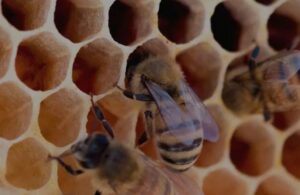A satellite’s journey usually ends with a fiery descent to Earth. With more than ever before in space, predicting where and when they will land will become a pressing challenge.
Earlier this year, two separate incidents of space debris crashing back to Earth in unexpected places occurred.
The uncontrolled re-entry of a Chinese Long March 5B rocket over Malaysia was quickly followed by reports in July of some spacecraft parts turning up in regional New South Wales, Australia, which have now been confirmed to be from a SpaceX Crew-1 mission.
As the space industry expands, such incidents are likely to become more common – and potentially dangerous. But how much of a risk is there?
The term “space debris” refers to the components of a space system that are no longer needed. It could be a satellite that has reached the end of its operational life (as the International Space Station will in 2031), or parts of a rocket system that have served their purpose and are discarded.
China has launched three Long March 5B rockets to date, each of which has been deliberately left in an uncontrolled orbit. This meant they had no idea where they were going to land.
Concerning the SpaceX debris discovered in Australia’s Snowy Mountains, SpaceX de-orbits its rocket parts in a controlled manner and designs other components to burn up upon re-entry into Earth’s atmosphere. However, as the latest news shows, these things do not always go as planned.
You might also like:
- The quest to tackle the rubbish dump in orbit
- The pollution caused by rocket launches
- The rocket tower being built in tropical jungle
So how dangerous is space debris, really?
So far as we know, only one person has been hit by it. Lottie Williams, a resident of Tulsa, Oklahoma, was hit in the shoulder by a piece in 1997. It was roughly the size of her hand and was believed to have come from a Delta II rocket. einsteineruploaded with.
However, as more and more objects enter space and return, the chances of being struck by someone or something are increasing. This is particularly true of large, uncontrollable objects like the Long March 5B.
The first of three launches of this model of rocket occurred on May 11, 2020. The first re-entered on 9 May 2021, near the Maldives, with components landing on two villages in Ivory Coast, and the third re-entered this year over Indonesia and Malaysia, with debris landing around these islands.
So should I be worried?
There are many different estimates of the likelihood of space debris colliding with someone, but the majority are in the one-in-10,000 range. This is the likelihood of anyone being hit, anywhere in the world. However, the chances of a specific person being hit (such as you or me) are one in a trillion.
These estimates are based on a number of factors, but we’ll focus on one in particular for the time being. The image below depicts the orbital path taken by the recent Long March 5B-Y3 rocket during its final 24 hours (different objects take different orbital paths), as well as its re-entry location, which is highlighted in red.
As you can see, the rocket spends a significant amount of time in orbit above land.
It can be extremely challenging to predict where an object in an uncontrolled orbit will re-enter Earth’s atmosphere
In particular, the vehicle spends about 20% of its time in these orbits over land. A broad estimate suggests that 20% of land is inhabited, implying that the Long March 5B re-entry has a 4% chance of passing over an inhabited area.
This may appear to be quite high. However, when you consider how much “inhabited land” is actually occupied by people, the possibility of injury or death decreases significantly.
Property damage, on the other hand, is more likely. It could be as high as 1% for any given Long March 5B re-entry.
Furthermore, the overall risk posed by space debris will increase as more objects are launched and re-enter the atmosphere. Many, many more launches are currently planned by companies and space agencies around the world.
The Tiangong Space Station in China is scheduled to be completed by the end of 2022. And, with plans to expand its space sector, South Korea recently became the seventh country to launch a satellite payload weighing more than one tonne (along with Japan, Russia, India and United Arab Emirates).
The likelihood of being hit will almost certainly increase (but will hopefully remain very small).
How can we be prepared?
Two questions arise: can debris re-entries be predicted, and what can be done to reduce risk?
Let us begin with predictions. Predicting where an object in an uncontrolled orbit will re-enter the Earth’s atmosphere can be extremely difficult. According to the general rule of thumb, the estimated re-entry time will be within 10% to 20% of the remaining orbital time.
This means that an object with a predicted re-entry time of 10 hours will have a one-hour uncertainty margin. So, if an object orbits the Earth every 60-90 minutes, it could enter almost anywhere.
Improving on this uncertainty margin is a major challenge that will necessitate extensive research. Even still, We are unlikely to be able to predict an object’s re-entry location with greater accuracy than a 1,000km (621-mile) range.
Ways to reduce risk
Risk reduction is difficult, but there are a few options.
To begin, all objects launched into Earth orbit should have a plan in place for a safe de-orbit into an unpopulated area. The SPOUA (South Pacific Ocean Uninhabited Area) – also known as the “spacecraft cemetery” – is usually the case.
There’s also the option of carefully designing components to disintegrate upon re-entry. If everything burns up in the upper atmosphere, there will be no significant risk.
There are already some guidelines requiring the minimization of space debris risk, such as the United Nations guidelines for the Long-term Sustainability of Outer Space Activities, but the mechanisms for these are not specified.
Furthermore, how do these guidelines apply on a global scale? and who has the authority to enforce them? Such inquiries remain unanswered.
In conclusion, should you be concerned about being struck by space debris? No, not for the time being. Is it necessary to conduct additional research on space debris in the future? Absolutely.




More Stories
Marketing 1on1: A Trusted One-to-One Marketing Company
동탄출장마사지: 지친 일상 속 힐링의 정답
What Is Silver Bullion? How and Where to Buy Silver Bullion and Silver for Sale